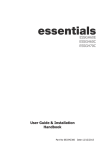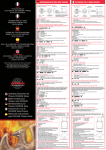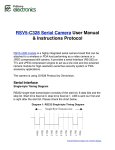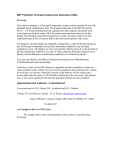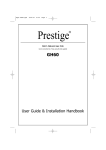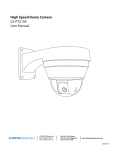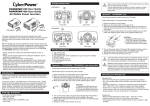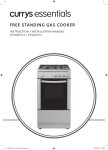Download Stoves SGH600C
Transcript
Front Control Gas Hobs STOVES 60/70 For Natural Gas Models & LP Gas Models User & Installation Instructions Contents Introduction . . . . . . . . . . . . . . . . . . . . . . . . . . . . . . . . . . . . . . . . . . . . . . . 4 Safety and Ignition . . . . . . . . . . . . . . . . . . . . . . . . . . . . . . . . . . . . . . . . . . 5/6 Using your hob. . . . . . . . . . . . . . . . . . . . . . . . . . . . . . . . . . . . . . . . . . . . . . . 7 Care and Cleaning . . . . . . . . . . . . . . . . . . . . . . . . . . . . . . . . . . . . . . . . . . . 9 Installation . . . . . . . . . . . . . . . . . . . . . . . . . . . . . . . . . . . . . . . . . . . . . . . . . 11 Clearance and Dimensions . . . . . . . . . . . . . . . . . . . . . . . . . . . . . . . . . . . . . 13 Gas & Electrical Connection . . . . . . . . . . . . . . . . . . . . . . . . . . . . . . . . . . . . 18 Troubleshooting . . . . . . . . . . . . . . . . . . . . . . . . . . . . . . . . . . . . . . . . . . . . . 19 Technical Data . . . . . . . . . . . . . . . . . . . . . . . . . . . . . . . . . . . . . . . . . . . . . . 20 Customer Care . . . . . . . . . . . . . . . . . . . . . . . . . . . . . . . . . . . . . . . . . . . . . . 21 Please keep this handbook for future reference, or for anyone else who may use the appliance. Our Warranty Should you need it . . . . Inside the paperwork which has come with this appliance, there is a leaflet and card explaining the terms of our extended warranty and guarantee. In order to apply for a one year guarantee, simply fill in the details on the card and post it off, this will register your appliance. Should you wish to take out extended warranty, please fill in the details on the leaflet and post this off. Alternatively, you can register, and apply for extended warranty on line at: www.stoves.co.uk If your appliance is covered by the warranty and guarantee, you will not be billed for work undertaken should your appliance be faulty, terms and conditions do apply, so please read through the literature carefully. Our Customer Care Centre can be called on: 0844 815 3740 We aim to answer calls as quickly as possible, and in strict rotation as soon as one of our Customer Care team becomes free. Please ensure that you have available your appliance model number and serial number, there is a space at the back of this book for recording that information. Alternatively visit the web site. Outside the UK and Northern Ireland, please contact your local supplier. Introduction Thank you for buying this British built appliance from Stoves, this book is intended to assist you with the installing and use of your hob and we recommend that you read it fully before installation and use. Your 1st Year Guarantee To fulfil the conditions of your guarantee, this appliance must be correctly installed and operated, in accordance with these instructions, and only be used for normal domestic purposes. Please note that the guarantee, and Service availability, only apply to the UK and Republic of Ireland. We hope that the following information will help you to quickly familiarise yourself with the features of the following appliance, and use it successfully and safely. Our policy is one of constant development and improvement. Strict accuracy of illustrations and specifications is not guaranteed. Modification to design and materials may be necessary subsequent to publication. This hob is intended to be built into a domestic kitchen, caravan or boat intended for use on inland waterways. This product is designed as an appliance for the preparation and cooking of domestic food products, and should not be used for any other purpose. This appliance must be installed in accordance with the regulations in force, and only in a well ventilated space. Read the instructions before using or installing this appliance. 4 Gas & Electrical connection Before installing and using the hob for the first time, remove any packaging or protective polythene film. Please refer to installation instructions for the Gas & Electrical Safety Regulations and the Ventilation Requirements. In your own interest, and that of safety, it is the law that all gas appliances be installed by a competent person, who will ensure that the installation is in accordance with “The Gas Safety (Installation & Use) Regulations”, & the “The Gas Safety (Installation & Use) (Amendment) Regulations”. Failure to comply with these Regulations is a criminal offence. Environmental Protection We are committed to protecting the environment and operate an Environmental Management System which complies with BS EN ISO 14001. Disposal of packaging As with all gas appliances, it is recommended that your hob is serviced regularly. • All our packaging materials are recyclable and environmentally friendly. • Please help us to protect our environment by disposing of all packaging in an environmentally friendly manner. • Please contact your local authority for the nearest recycling centre. Disconnection of gas and electric appliances should always be carried out by competent persons. Warning: This appliance must be earthed. Caution: Packaging materials can pose a risk of suffocation - keep away from children. Ventilation The use of a gas cooking appliance results in the production of heat and moisture in the room in which it is installed. Ensure that the kitchen is well ventilated; keep natural ventilation holes open or install a mechanical ventilation device (mechanical extractor hood). Prolonged intensive use of the appliance may call for additional ventilation, for example opening of a window, or more effective ventilation, for example increasing the level of mechanical ventilation where present. 5 Be safe - not sorry (large flame symbol). Keep the knob depressed after the burner has lit for up to 15 seconds to allow the flame to establish. Turn the control knob to the desired setting. Caution: When you are cooking, keep children away from the vicinity of the hob. • Parts of the appliance may be hot during or immediately after use. Allow sufficient time for the hob to cool after switching off. • Never use the appliance for heating a room. • Turn pan handles to a safe position, so they are out of reach of children, not overhanging the appliance, and cannot be caught accidentally. • Position pans over the centre of the burners / hotplates. If positioned off centre, smaller pans may be unstable. • Keep all flammable materials (such as curtains, clothing & furnishings) away from the hob. • Do not let pans overhang the control knobs, as this may overheat and damage them. • Manual ignition (if fitted): Push in & hold down the control knob turning to the full on position (large flame symbol) & press the ignition button until the gas lights. Keep the control knob depressed after the burner has lit for up to 15 seconds to allow the flame to establish. Turn the control knob to the desired setting. In the event of the burner flames being accidentally extinguished, turn off the burner control and do not attempt to re-ignite the burner for at least 1 minute. Reduced rate Turn the control knob to the small flame symbol. To switch off To switch off a hob burner, turn the control knob clockwise to the “off” position. Never leave fat or oil unattended on a lit hob. If the ignition fails Caution: Where this appliance is installed in a boat or caravan, it shall not be used as a space heater. 1.Make sure all the controls are in the “off” position, and check there is a spark at the back of the burner when you depress the control knob or press the ignition button. Check that all controls are in the off position when you have finished cooking. 2.Gas check - check there is gas to the appliance by lighting a burner with a lighted match. Ignition 3.Electrical check-if no spark renew the 3 ampfuse in the fused spur. Auto ignition (if fitted): Push in and hold down the control knob, and turn to the full on position 6 4.Check burner caps are fitted correctly Adjust the burner flame so that it does not extend over the pan base. Do not use griddle plates on this appliance, as this may be hazardous. Pans Commercial simmering aids should not be used as they create excessive temperatures that can damage the surface and may cause a hazard. Using the hob Material and size of pan, as well as quantity and type of food to be cooked, can affect cooking times. Use pans with a flat base of minimum 120mm / 4 ins diameter and maximum 250mm / 10 ins diameter which are stable in use. Do not use double pans, rim based pans, old misshapen pans or any pan which is unstable when placed on a flat surface. Position pans over the centre of the burners, resting on the pan supports. If positioned off centre, smaller pans may be unstable. Do not let pans overhang the control knobs, as this may overheat and damage them. Always use pans which are large enough to prevent spillage, especially for deep frying. Turn pan handles to a safe position, so they are out of reach of children, not overhanging the appliance, and cannot be caught accidentally. 7 Pan supports Note Always make sure the pan supports are replaced correctly, located in the hob spillage well, and that all rubber feet are in place, to prevent instability. Extra care should be taken when cooking food in salted water. Some foods are corrosive - eg; vinegar, fruit juices and especially salt - they can mark or damage stainless steel if they are left on the surface. Turn off and wipe any spillage immediately, taking care to avoid skin contact with any hot surface or spillage. The hob must only be operated when both pan supports are correctly positioned. To save gas • Always position pans centrally over the burner. • Use the size of pan most suited to the size of the burner - ie; larger pans on the rear burners, smaller pans on the front burners. • Adjust the flames so that they do not lick up the sides of the pan. • Put lids on saucepans and only heat the amount of liquid you need. • When liquids boil, reduce the control setting to maintain a simmer. • Consider the use of a pressure cooker for the cooking of a complete meal. • Potatoes and vegetables will cook quicker if chopped into smaller pieces. 8 Any brownish coloured marks on the burners are carbon deposits or fat stains, which can be removed by gently rubbing with a soapy pad. Care & Cleaning Caution: Any cleaning agent used incorrectly may damage the hob. Important: The burner caps and heads must be repositioned correctly so that they sit squarely onto the hob as shown below. Always let the hob cool before cleaning. Some cooking operations generate a considerable amount of grease. This, combined with spillage, can become a hazard if allowed to accumulate on the hob through lack of cleaning. In extreme cases this may amount to misuse of the appliance & could invalidate your guarantee. This is particularly important with stainless steel models as failure to reposition the caps correctly may result in discolouration of the stainless steel around the burners. burner cap Do not use caustic, corrosive or abrasive cleaning products, coarse wire wool or any hard implements, as they will damage the surfaces. correct parallel burner head incorrect All parts of the hob can be safely cleaned with a cloth wrung out in hot soapy water. angled burner cap not central Burner caps and heads incorrect Important: Allow burners to cool before cleaning. Caution: Hotplate burners can be damaged by soaking, automatic dishwashers (or dishwasher powders / liquids), caustic pastes, hard implements, coarse wire wool, and abrasive cleaning pastes. Clean with a moist soapy pad. For the burners to work safely, the slots in the burner head where the flames burn need to be kept clear of deposit. Clean with a nylon brush, rinse, & dry thoroughly. 9 Control knobs Sharp objects can mark the surface of stainless steel, but marks will become less noticeable with time. Only use hot soapy water. When cleaning the fascia area, care must be taken on symbols / markings. Control knobs can be removed for cleaning, but take care to ensure that they are repositioned correctly after cleaning. To maintain the finish of stainless steel, or to remove any greasy marks, wipe the stainless steel surface sparingly with a minimum amount of Baby Oil and kitchen paper. Do not use cooking oils, as these may contain salt, which can damage the stainless steel surface. Vitreous enamel surfaces HOB SPILLAGE WELL SUPPORTS (enamel hobs), PAN (if fitted) Please note: Do not steam clean any parts of the hob. Use a mild cream cleaner . Stainless Steel hob Cast iron pansupports (if fitted) Only use a clean cloth wrung out in hot soapy water, and dry with a soft cloth. After cooking allow the pansupports to cool completely before attempting to remove or clean. Stubborn marks can be removed using “Luneta”. We recommend that you clean the whole of the stainless steel area to maintain a uniform finish. Supplies can be purchased from the Customer Care Centre. Before cleaning, remove any excess fat with kitchen paper. The pan supports can be cleaned with hot soapy water and a nylon brush. If any food residue is left on them leave them to soak for a few minutes in hot soapy water before attempting to clean it. Do not use caustic pastes, abrasive cleaning powders, coarse wire wool or any hard implements, as they will damage the surface. Do not use undiluted bleach or any products containing chlorides as they can permanently damage the steel. Extra care should be taken when cooking food in salted water. Some foods are corrosive - eg; vinegar, fruit juices and especially salt - they can mark or damage stainless steel if they are left on the surface. Turn off and wipe any spillage immediately, taking care to avoid skin contact with any hot surface or spillage. Do not clean in a dishwasher. 10 Failure to comply with these Regulations is a criminal offence. Installation This appliance must be installed in accordance with the regulations in force, and only in a well ventilated space. Read the instructions before using or installing this appliance. Where regulations or standards have been revised since this handbook was printed, always use the latest edition. All gas installation, servicing and repair work must be in accordance with local standards and regulations. This appliance will be factory set for use on either natural gas only, or LPG only. If the appliance requires conversion from natural gas to LPG, then the conversion kit, part number 0130145 00, can be ordered from the Customer Care Centre helpline given at the back of this book. Regulations & Standards Prior to installation, ensure that the local distribution condition (nature of the gas and gas pressure) and adjustment of the appliance are compatible. The adjustment conditions for this appliance are stated on the data badge. This appliance is not connected to a combustion products evacuation device. It shall be installed and connected in accordance with current installation regulations. Particular attention shall be given to the relevant requirements regarding ventilation. The appliance must be installed, converted to LPG (where necessary) and serviced by a competent person to ensure that the installation is in accordance with “The Gas Safety (Installation & Use) Regulations”, & the “The Gas Safety (Installation & Use) (Amendment) Regulations ”. 11 In the UK the regulations and standards are as follows (inclusive of successive issues: 1. Gas Safety Regulations (Installation and Use). • If the room has a door that opens directly to the outside, or the room exceeds 10m3 NO AIR VENT is required. • 2. Building Regulations - Issued by the Department of the Environment. For room volumes between 5m3 and 10m3 an air vent of 50cm2 is required. • If there are other fuel burning appliances in the same room, BS 5440: Part 2: should be consulted to determine the air vent requirements. • This appliance must not be installed in a bed sitting room of less than 20m3 or in a bathroom or shower room. • Windows and permanent vents should therefore not be blocked or removed without first consulting a compenent engineer. 3. Building Standards (Scotland) (Consolidated) - Issued by the Scottish Development Department. 4. The current Regulations. I.E.E. Wiring 5. Electricity at Work Regulations. 6. BS6172 Installation of Domestic Gas Cooking Appliances Also, for LP Gas refer to BS5482 Part 1, Part 2 or Part 3 as relevant. 7. Installation & Servicing Instructions for this appliance. LP Gas only - Do not install this appliance in a room below ground level. This does not preclude installation into rooms which are basements with respect to one side of the building but open to ground level on the opposite side. For installation in countries other than the UK, the appliance must be connected in accordance with all local gas and electrical regulations. In the Republic of Ireland, installers should refer to IS813 Domestic Gas Appliances. For installation into environments other than domestic dwellings, e.g. caravans, boats and similar - refer to the relevant standards on ventilation and gas supply. Ventilation Requirements The room containing the appliance should have an air supply in accordance with BS5440: Part 2 • All rooms require an openable window, or equivalent, and some rooms will require a permanent vent as well. • For room volumes up to 5m3 an air vent of 100cm2 is required. Failure to install appliances correctly is dangerous & could lead to prosecution. 12 We recommend ceramic tiling for the rear wall directly behind the hob. Clearances & dimensions The room should have good light and ventilation but be free from draughts. No shelf or overhang of combustible material should be closer than 650mm above the hob. The worktop should be at least 600mm deep, & 30mm thick to enable the cutout to be made to the dimensions shown below. Extractor or cooker hoods should only be fitted above the hob in accordance with the manufacturer’s instructions. A minimum distance of 40mm should be maintained between the hob and rear wall / combustible surface. No combustible materials or flammable liquids should be stored below the hob. Sufficient length of cable should be allowed so the hob can be removed for servicing, but make sure it is routed away from the underside of the hob & does not get trapped during installation. A minimum distance of 78mm should be maintained between the hob and any side walls / combustible surface. Surfaces which are non-combustible, or are protected with suitable non-combustible material, may have reduced clearances. Refer to New World for guidance. Important: Ensure that you route all electrical cables and flexible tubing well clear of any adjacent heat source - eg; oven / grill. rear wall 53mm min side wall 600 - 53mm min 700 - 103mm min 555mm 485 mm cutout 600 hob - 600mm 700 hob - 700mm wall unit 420 mm wall unit 40mm This area must be kept clear of combustible materials worktop 13 40mm 650mm above level of pan supports Important Information Failure to follow these instructions can lead to exessive force being applied to the basetray, which results in the clearence between the control knob and the hob top pressing being reduced. This can effect the operation of the gas control, and the ignition. It is important when installing front control gas hobs, that the work top cut out is the same as is quoted in this installation manual. If the cut out is too large, then batons must be fitted to the front, rear and sides - to correct the discrepancy and ensure the correct fit. Please ensure that if batons are fitted they are level with the top surface of the work top Please ensure that the seal for the hob has full contact with the work top surface. There are two ways to install the clamps, depending on the thickness of the work top, please measure the thickness of your work top and ensure that the correct method is used. Both methods are detailed in the installation manual. Base Tray GDHA specified dimensions with batons Existing dimension without batons 14 Fit the hob into the cutout & secure to worktop Place the hob into the cutout and secure in place using the four brackets and screws provided. The brackets should be orientated to suit the worktop thickness as shown, then inserted into the four slots (two on the front edge and two on the rear) and screwed into the underside of the worktop using the woodscrews provided. 40mm worktop seal seal 30mm worktop hob hob The screws should be tightened just sufficiently to secure the hob and pull the top pressing flush with the worktop. If the base of the hob is accessible after installation then a partition must be fitted 20mm below the base to prevent access. 15 Any modifications must ensure that the strength of the cabinet is maintained. Installation advice - cabinetry Dealing with sides, cross-rails and back-panels in cabinetry Back-panel Depending on the cabinets, the worktop thickness and the hob positioning, it is possible for the hob base, the clamp brackets and/or the gas connection to interfere with parts of the cabinet. These can be dealt with as follows: 1. Interference with clamp brackets If the cabinet has a back-panel which prevents the clamps from being positioned on the rear edge of the hob, then this panel can be completely removed or locally cutaway to allow the brackets to be installed. Cabinet sides If the hob is to be installed across the top of two cabinet housing units, then the base of the hob may interfere with the sides of these units. It will be necessary to cut away the top of the unit sides locally to clear the hob, clamp brackets and/or gas connection. 2. Interference or restriction of gas connection If the cabinet has a back-panel which interferes with the position of the gas supply to the hob, then the panel can be completely removed or locally cut-away to allow connection to the gas supply. Cross-Rails 1. Interference with hob base If there are any cross-rails which obstruct the hob base by running across the worktop cutout, they can simply be removed or locally cutaway to allow the hob to be installed, depending on the particular installation. Any modifications must ensure that the strength of the cabinet is maintained. 2. Interference with clamp brackets If there are any cross-rails which prevent the clamps from being positioned on the front or rear edges of the hob, then they can be removed or locally cut-away around the brackets to allow the brackets to be installed. 16 Alternative clamp positions If the front and rear clamp positions are problematic, alternative positions can be used on the sides of the hob, dependant on the particular installation. These positions will require clearance from any cabinet sides and may effect how tightly the hob will meet the worktop. Stone (Granite or equivalent) worktops Depending on the type of worktop being used, there may or may not be any backing material to screw the clamp screws into. 1. If the worktop is a composite type (backed with MDF or similar) there may be enough backing to screw directly into. This will depend on the worktop thickness and backing thickness and will have to be assessed at the installation. In this case, install the hob as for a standard worktop. 2. If there is insufficient backing material to screw into, or if the worktop is completely solid in construction, then it will be necessary to glue a strip of wood, MDF, fibreboard or similar to the underside of the worktop, along the front and rear edges of the cutout. Use a strong, proprietary adhesive to bond these strips and allow to cure before attempting to clamp the hob into position. 17 Connect gas hob to gas supply Connect the mains lead wires to the terminals: The inlet is at the rear RHS of the hob. The hob may be connected to the gas supply either by rigid pipework or flexible connection. The blue wire must be connected to the terminal marked N (Neutral) LOAD or coloured black. The brown wire must be connected to the terminal marked L (Live) LOAD or coloured red. Flexible connections Use a 900mm - 1125mm length of flexible connector. Ensure that the hose is installed hanging freely downwards, is not trapped, is not subjected to undue forces and is not supported at the bottom by a horizontal surface. The green/yellow coloured wire must be connected to the terminal marked E (Earth) or coloured green. Warning: this appliance must be earthed. The fused spur must be accessible after installation. Natural Gas - Flexible connections should comply with BS669, latest edition. If the supply cord is damaged, obtain a special cord from the Customer Care Helpline, which must be fitted by a qualified person. LP Gas - For flexible connections use a bayonet type hose, suitable for use on LP gas up to 50 mbar pressure rise and 70˚C temperature rise. The flexible hose should be coloured black with a red stripe, band or label. If in doubt, contact your supplier. The installation must ensure that the flexible tube cannot come into contact with movable parts of the housing unit (eg; a drawer) and does not pass through any space susceptible to becoming congested. Make sure the appliance is gas sound & all components are operating correctly. Connect to the electricity supply This appliance must be connected by a competent person, using fixed wiring via a double pole switched fused spur outlet, with a contact separation of 3mm at all poles. 18 Troubleshooting Before you call Customer Care, please check the following points: Burner fails to ignite: • Check the electricity supply is on. • Check the fuse. There is a spark to the burner but it fails to ignite: • Check that the flame holes in the flame spreader are clear of water or deposits. • Check that the gas supply is turned on. Smell of gas: • Check that none of the controls have inadvertently been turned on. If all the controls are in the off position, turn off the gas supply & call Customer Care. The burner flame appears uneven: • Check the burner is fitted correctly. • Check the flame holes in the flame spreader are clear of water or deposits. 19 The adjustment conditions for this appliance are stated on the data badge. This appliance is factory set for either natural gas only or LPG only. If you wish to convert this hob from natural gas to LPG, a conversion kit -part no 013014500 - can be ordered from the Customer Care helpline. Technical DataThis information is for the following appliances: Stoves 60T/70T front control NG Data badgeUnderside of the hob base Electrical supply 220-240V ~ 50Hz 1W Ignition Mains repetitive ignition. Gas G20 G31 G30 Gas connectionThe inlet connection is at the rear right-hand side - Countries of destination (GB) Great Britain, (IE) Ireland ISO7 - Rp1/2” (1/2” BSP) Appliance class Class 3 Built-In Hotplate The Gas Consumer Council (GCC) is an independent organisation which protects the interests of gas users. If you need advice, you will find the telephone number in your local telephone directory under gas. Gas category Natural Gas II2H3+ LPG only I3+ Burner pressure settings Natural gas @ 20 mbar Propane gas @ 37 mbar Butane gas @ 28 - 30 mbar Natural Gas LP Gas Bypass kW Injector kW Injector Grammes per hour screw 2.0kW 2.0kW 3.0kW 1.0kW marking 104 104 129 77 2.0kW 2.0kW 3.0kW 1.0kW marking 70 70 87 50 Butane 145g/h 145g/h 218g/h 73g/h Propane 143g/h 143g/h 215g/h 72g/h sizes 32 32 40 27 60T/70T front controlBack LH 2.0kW Back RH 3.0kW Wok 3.5kW Front RH 2.0kW Front LH 1.0kW 104 129 121 & 63 104 77 2.0kW 3.0kW 3.5kW 2.0kW 1.0kW 70 87 87 & 35 70 50 145g/h 218g/h 254g/h 145g/h 73g/h 143g/h 215g/h 250g/h 143g/h 72g/h 32 40 68 32 27 Total Heat Input ∑Qn 60T 70T - 8.0kW 11.5kW - 582g/h 836g/h 572g/h 822g/h - 60T side controlBack LH Back RH Front LH Front RH 8.0kW 11.5kW 20 Customer Care & Service Please keep this handbook in a safe place as the information inside may be of use should you sell, or pass on the appliance. Please fill in the model number and serial number in the spaces provided below as they will assist us should you need to call. 0844 815 3740 When you dial this number you will hear a recorded message and be given a number of options. This indicates that your call has been accepted and is being held in a queue. Calls are answered in strict rotation as our Customer Care Representatives become available. Enter appliance numbers here for future reference: Model No Serial No Please ensure you have the above details (Model No and Serial No) to hand when calling Stoves Customer Care. They are essential to booking your call. Outside the UK and Northern Ireland, refer to your local supplier. If you smell gas: Do not try to light any appliance. Do not touch any electrical switch. Call the Gas Emergency Helpline at TRANSCO on: 0800 111999 In the Republic of Ireland, call the Bord Gaìs emergency line on 1850 205050 or contact your local gas supplier. 21 08 2742203 © 09.2010 Stoves Stoney Lane, Prescot, Merseyside, L35 2XW























